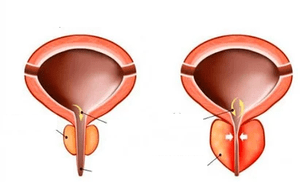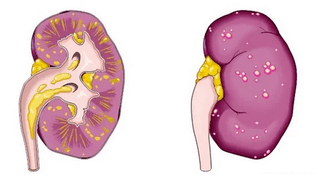
Many doctors jokingly refer to prostatitis as male menopause. Among men after 40 years of age, 20% of cases are diagnosed with this disease, in 70% of cases after 60, and in cases after 70, 90% of cases are diagnosed. The disease can occur in two forms: acute and chronic prostatitis. This disease must be treated, especially because it is well suited for treatment. But many men ignore the unpleasant symptoms, which leads to the development of many complications, which become more difficult to cure.
Reason for development
Acute prostatitis is an acute pathology of the prostate, which is the result of inflammation and infection processes in the organs due to the penetration of pathogens into its tissues. The disease is characterized by swollen glands and purulent contents in the tissues.This can lead to many unpleasant symptoms, which violate the function of the genitourinary system organs.
There are many reasons for acute prostatitis. In most cases, it is caused by the pathogenic microorganism.Some microorganisms can passively exist in the skin or intestines of healthy people. Under the influence of certain factors, they are activated, penetrate into the glandular tissue and actively multiply there. This disease is usually caused by venereal diseases, such asChlamydia, Ureaplasmosis, Gonorrheaetc.
In addition, the acute form of prostatitis is a complication ofurethritis. Bacteria enter through a catheter that enters the urethra. Similarly, the cause of prostatitis is usually the spread of bacteria from other organs in the urogenital system. Normally, the glands will be affectedduring surgery, catheterization, and diagnostic measures.
Due to the large number of blood vessels in the prostate, when the human body develops chronic diseases (such astonsillitis, bronchitis, etc. ), infection will enter the bloodstream here.In the presence ofanal fissure, microorganisms may enter the prostate with lymph fluid.
However, infection does not always lead to the development of disease. Blood vessel congestion in the pelvic area develops intoduring long periods of sexual intercourse or mass sexual abstinence.
Congestion is also associated withlack of physical activity, persistent constipation, alcohol abuse, varicose veins in the pelvic area, and hypothermia.
Classification
In urology, pathology is divided into several forms, which are also the stages of development:
- The catarrhal formis characterized by inflammation in the organs and changes in the mucosal epithelium. Over time, the glands will swell, and the secrets of dense mucus will be collected in them, leading to the development of the disease.
- Then there was focal suppuration. The disease enters the second stage (form)-follicular form. The urinary catheter is narrowed or blocked, and the secret is no longer normally discharged from the organ. Pus can be secreted into the urinary tract, where purulent foci form. The gland cells change and the prostate continues to swell and enlarge.
- Theparenchymal formdevelops when the organ is completely inflamed, and a purulent infection is formed in it. Without treatment, the small purulent foci fuse into a huge abscess, forming an abscess, which often leads to the urethra, bowel, and bladder. In some cases, when the infection enters the interstitial tissue of the organ through the blood or lymph fluid, it may develop into this pathological form immediately.

Symptoms
Shows the symptoms of acute prostatitis. The intensity of the signs and feelings depends on the form (stage) of the disease. Common signs of the disease include:
- pain syndrome in urinary excretion;
- Symptoms of poisoning; Pain in the genital area;
- Often urged to go to the toilet, especially at night;
- may be discharged from the urethra.
As male prostatitis develops, the pain syndrome will spread to other areas. This is due to the transmission of impulses along the nerve endings. Urine excretion becomes very painful. An acute delay usually occurs at this stage, which is considered a dangerous condition because it can cause the bladder to rupture.
The symptoms of acute prostatitis continue to worsen. Severe pain during defecation and increased body temperature. The prostate becomes swollen, tight and painful. Due to the content of pus and mucus, urine can become cloudy.
In the final stage, this disease manifests strongly.
The body temperature is greatly increased, accompanied by fever, chills, loss of appetite, severe weakness, and exhaustion. Urination may stop completely, and the man will suffer severe pain when going to the toilet. This situation is unbearable, and the pain syndrome begins to spread throughout the pelvic area. A man could not find his home, he was forced to lie on all fours. If the inflammation has spread to the rectum, then mucus will come out of the anus. Yellow-green mucus is mixed with blood and released from the urinary tract.

This condition may causesepsis, cystitis, pyelonephritis, chronic prostatitis, abscess. In this case, emergency hospitalization and emergency treatment are required for the patient.
Diagnosis
As the symptoms of acute prostatitis in men are very obvious, the doctor may immediately suspect the pathology. But he needs a thorough inspection. In this case, rectal examination is strictly prohibited.
The urologist must use laboratory and instrument technology to determine the stage (form) of the disease. The doctor needsProstate Secretsto be checked. The concentration of white blood cells will increase, which indicates acute inflammation.
then performblood and urine laboratory tests. Urine is sent for bacterial culture for examination and to determine the pathogen of the infection and its susceptibility to antibacterial drugs. You can also:
- PCR for STD detection;
- Urine flow measurement method to identify the severity of organ diseases;
- Ultrasound examination of the prostate to determine the shape and size of the organ, its changes, and the stage of the disease;
- Doppler can help distinguish acute prostatitis from other diseases;
- When planning a surgical operation, MRI examination of the pelvic organs is usually prescribed;
- Analyze the concentration of SPA in the blood;
- Check urethral secretions smear;
- To puncture the organ site that is suspected of purulent infection and abscess.
Treatment
The urologist will tell you in detail how to treat acute prostatitis. The main ingredient of treatment is antibacterial drugs, which should be selected according to the results of bacterial culture. Within two or three days, antibiotics started to work, people felt much better, and the pain began to decrease. But for this form of disease, even if the symptoms disappear completely, such drugs need to be taken for one month.
It is also necessary to prevent this disease from becoming chronic, which is very common.
When choosing drugs, doctors will consider other factors:
- Some drugs do not penetrate the glandular tissue well.
- A large amount of other medicines accumulate in the tissues.
The treatment of acute prostatitis in men should be based on the use of powerful drugs, even in other life-threatening situations. Usually, doctors prescribe fluoroquinolones. When using macrolides, the dosage should be larger. This is especially true in immunosuppressed patients.
Antibiotics are usually given by intravenous injection. In the initial stage, the disease can be treated at home or outpatient.In this case, bed rest is necessary because any power load may cause the spread of infection and the development of sepsis.
When combined with antibiotics, the following drugs are also prescribed:
- Analgesics;
- Antipyretic;
- NSAID;
- For severe pain, you can prescribe opiates;
- Diuretics can reduce human poisoning;
- Laxatives to promote bowel movements;
- Antispasmodic, promote urine excretion;
- Alpha blocker.
If a person has acute urine retention, urea catheterization is performed. Antiandrogens are usually used to reduce swelling and inflammation of organs, improve the outflow of secretions, normalize blood flow to the glands and reduce the risk of infection spreading throughout the body.
Use estrogen, cold enema and other hormones to relieve swelling and pain. Massage and hyperthermia for the disease are strictly prohibited. They can only be applied during recovery.
Surgery

In the absence of pain, the doctor may suspect the development of an abscess. In this case, surgical intervention will be performed to eliminate the area where the operation occurred. Abscesses are usually drained by puncture. In severe and extreme cases, the organ is removed.
Surgery is performed in the case of abscesses, acute retention of urine, severe pain syndrome that cannot be eliminated with any medication, the appearance of stones and tumors, and the ineffective drug treatment, frequent infections of the genitourinary system, and paragastrointestinal inflammation.
The surgeon may use one of the following techniques:
- TRUP (transurethral resection)involves the removal of internal organs. Most commonly used;
- Prostatectomyinvolves partial or complete removal of organs through an incision in the lower abdomen;
- Laser surgery. In this case, a laser can be used to remove the affected area of the organ.
- The abscess is drained through the rectum. Insert a drainage tube at the incision, and drain the pus through the drainage tube.
- To facilitate the discharge of urine, atransurethral incisionwas made in the organ.
When the tissue structure of the gland is restored, its function is normalized, the secret of the prostate normalizes its composition, and the pathological cause is completely eliminated from the human body, we can talk about the treatment of prostatitis.
Forecast
With treatment, the prognosis of the disease will be very good. Sometimes there will be adverse consequences of acute prostatitis. The disease may become chronic, so it will be more difficult to eliminate. The dangerous consequences of untreated diseases are organ abscesses, sepsis, and acute retention of urine. In some cases, death may result due to complications. But usually, men do not allow this kind of consequence to happen because they will go to the doctor and start a course of treatment.
Prevention

For the sake of prevention, it is necessary to prevent the emergence of predisposing factors. This requires timely treatment of all infections in the body so that they do not become chronic diseases or become potential focal points of infection that can spread to the prostate.
When performing surgery, doctors should pay attention to the use of antiseptics. Otherwise, the risk of bacteria entering the patient's body will increase. It is very important for men and their sexual partners to treat STDs in time, and it is best to prevent STDs. Sex should be carried out with a fixed partner, which should be fixed.
It is necessary to live an active lifestyle, exercise or exercise, and abide by the privacy rules.
In an emergency, men usually seek medical advice. However, when there are negative signs, it is best to contact them immediately. This will help avoid many health problems and even save lives.
























